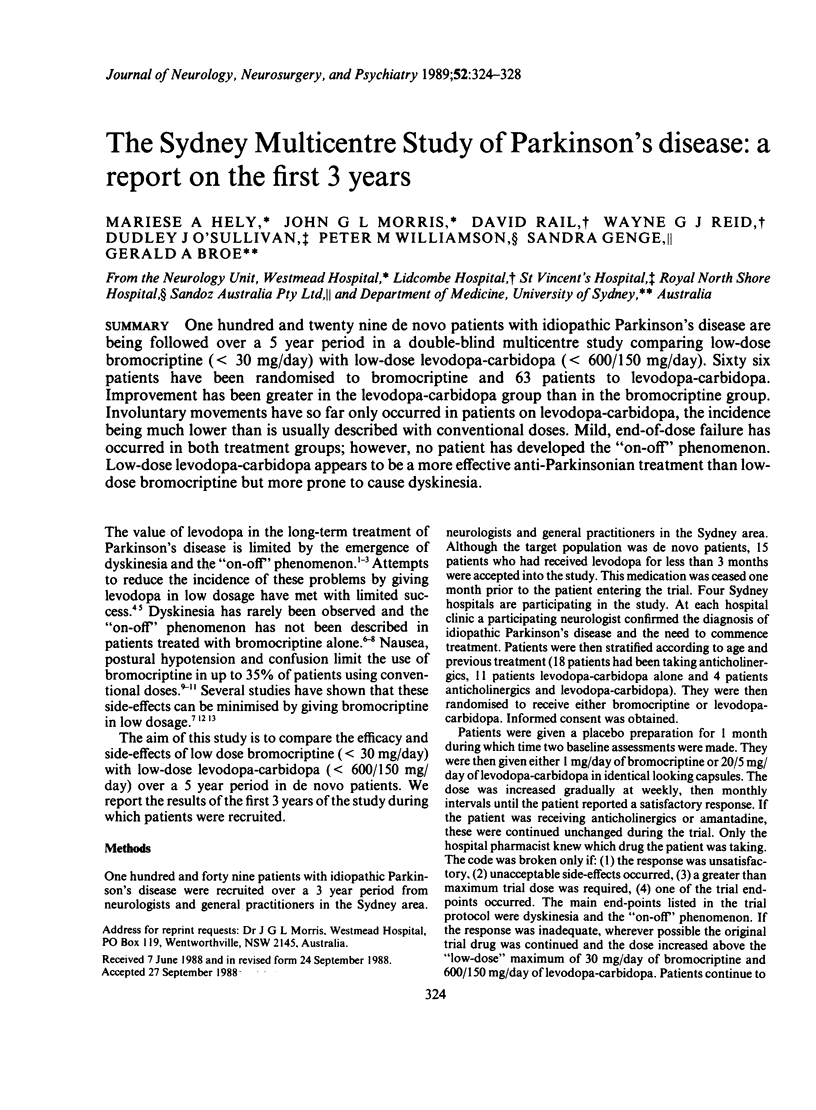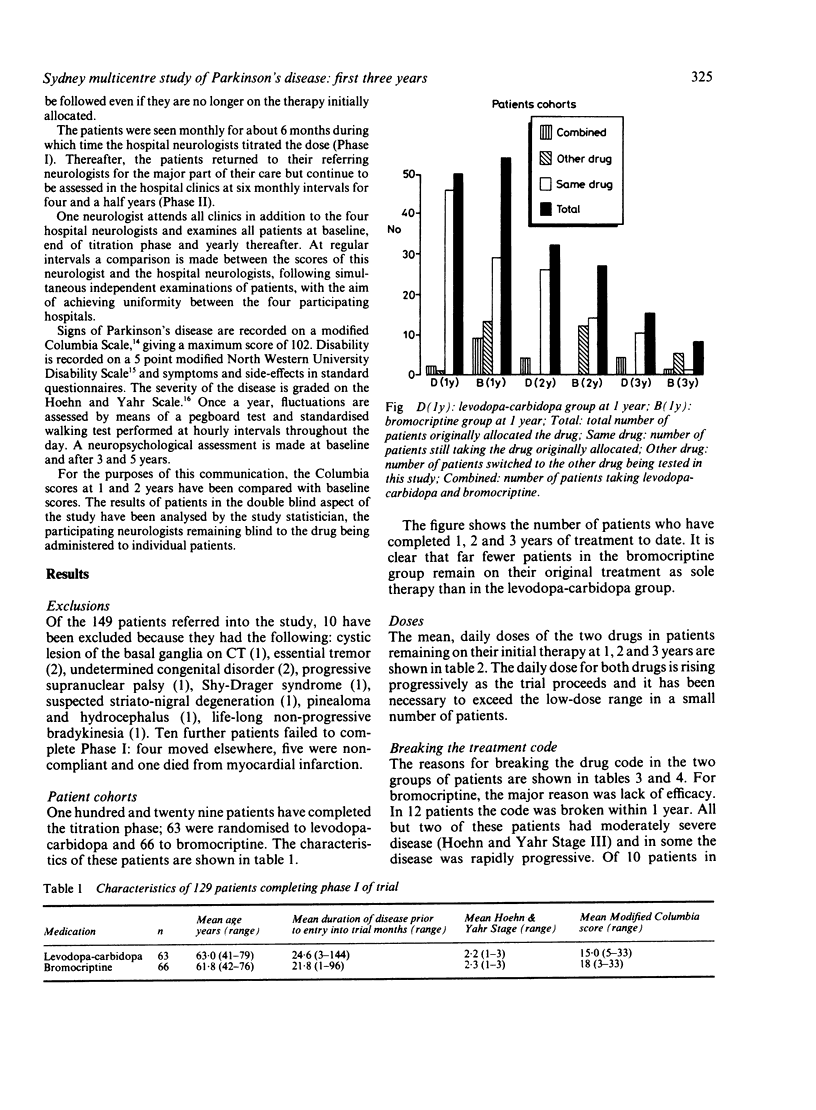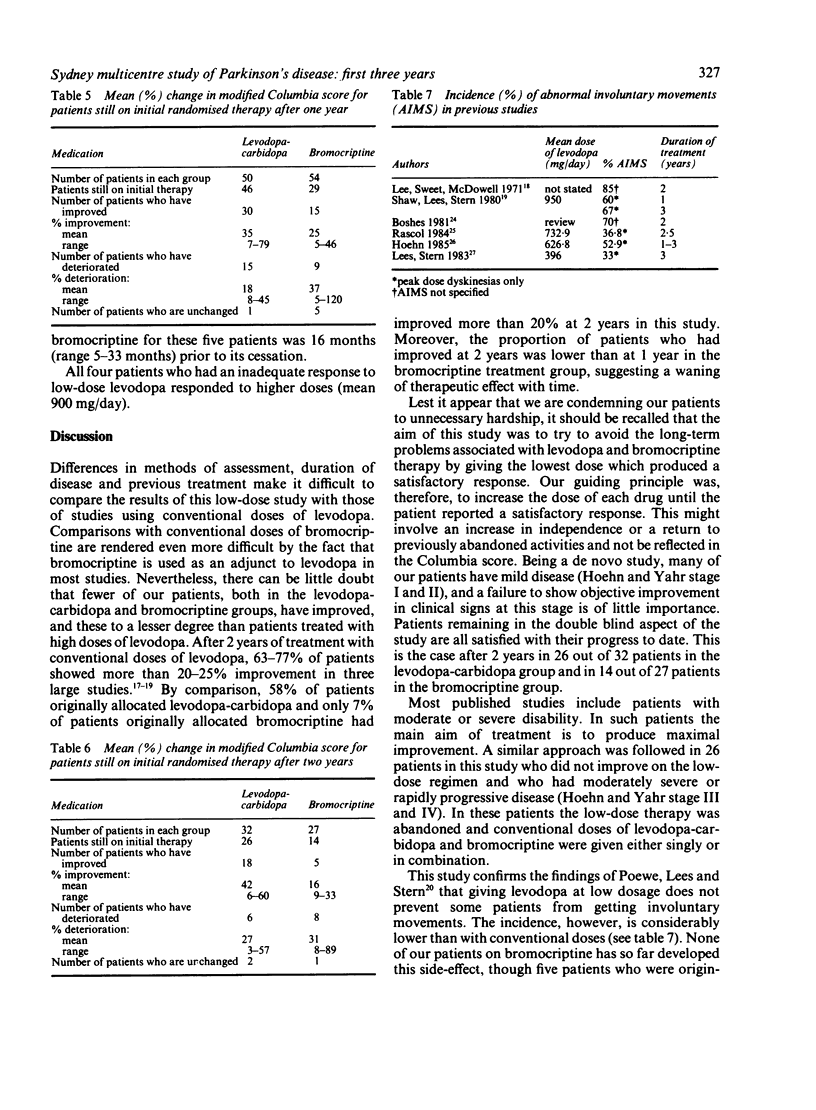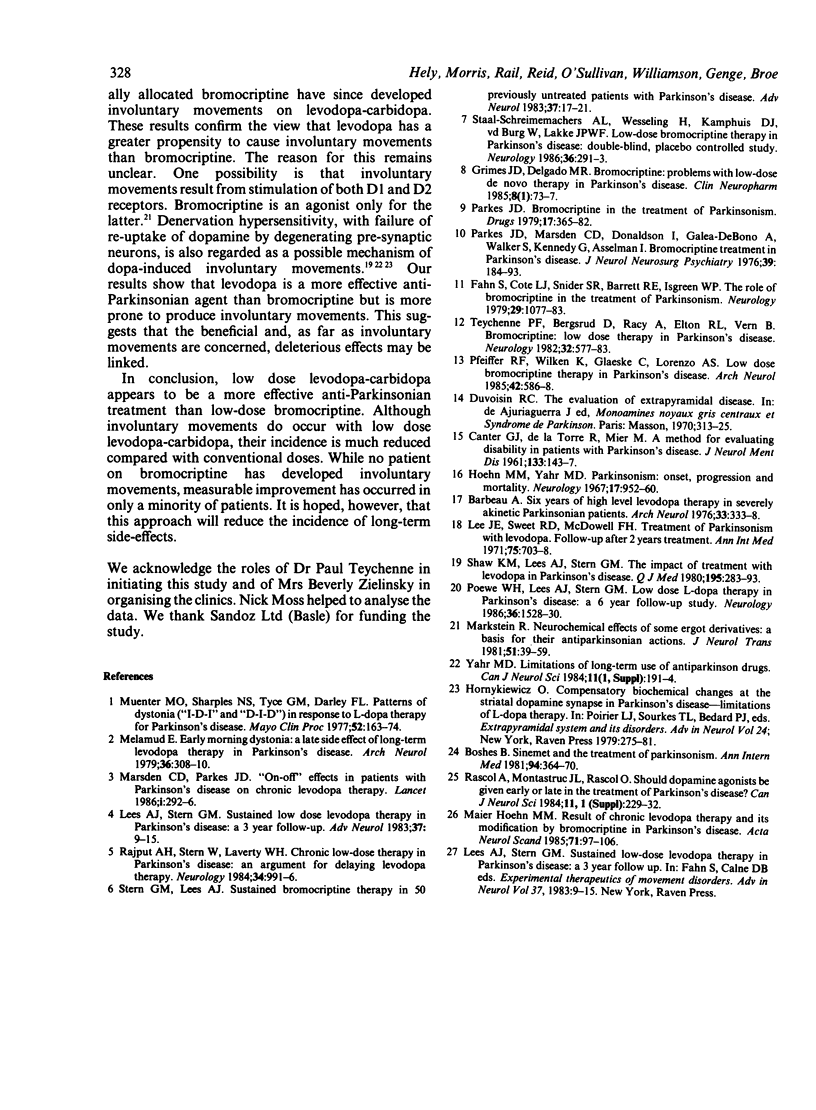Abstract
One hundred and twenty nine de novo patients with idiopathic Parkinson's disease are being followed over a 5 year period in a double-blind multicentre study comparing low-dose bromocriptine (less than 30 mg/day) with low-dose levodopa-carbidopa (less than 600/150 mg/day). Sixty six patients have been randomised to bromocriptine and 63 patients to levodopa-carbidopa. Improvement has been greater in the levodopa-carbidopa group than in the bromocriptine group. Involuntary movements have so far only occurred in patients on levodopa-carbidopa, the incidence being much lower than is usually described with conventional doses. Mild, end-of-dose failure has occurred in both treatment groups; however, no patient has developed the "on-off" phenomenon. Low-dose levodopa-carbidopa appears to be a more effective anti-Parkinsonian treatment than low-dose bromocriptine but more prone to cause dyskinesia.
Full text
PDF




Selected References
These references are in PubMed. This may not be the complete list of references from this article.
- Barbeau A. Six years of high-level levodopa therapy in severely akinetic parkinsonian patients. Arch Neurol. 1976 May;33(5):333–338. doi: 10.1001/archneur.1976.00500050019004. [DOI] [PubMed] [Google Scholar]
- Boshes B. Sinemet and the treatment of Parkinsonism. Ann Intern Med. 1981 Mar;94(3):364–370. doi: 10.7326/0003-4819-94-3-364. [DOI] [PubMed] [Google Scholar]
- CANTER G. J., DE LA TORRE R., MIER M. A method for evaluating disability in patients with Parkinson's disease. J Nerv Ment Dis. 1961 Aug;133:143–147. doi: 10.1097/00005053-196108000-00010. [DOI] [PubMed] [Google Scholar]
- Fahn S., Cote L. J., Snider S. R., Barrett R. E., Isgreen W. P. The role of bromocriptine in the treatment of parkinsonism. Neurology. 1979 Aug;29(8):1077–1083. doi: 10.1212/wnl.29.8.1077. [DOI] [PubMed] [Google Scholar]
- Grimes J. D., Delgado M. R. Bromocriptine: problems with low-dose de novo therapy in Parkinson's disease. Clin Neuropharmacol. 1985;8(1):73–77. [PubMed] [Google Scholar]
- Hoehn M. M. Result of chronic levodopa therapy and its modification by bromocriptine in Parkinson's disease. Acta Neurol Scand. 1985 Feb;71(2):97–106. doi: 10.1111/j.1600-0404.1985.tb03173.x. [DOI] [PubMed] [Google Scholar]
- Hofmann W. W., Angel R. W. Transient responses of the normal and diseased motor system to sudden load changes. Neurology. 1967 Oct;17(10):952–960. doi: 10.1212/wnl.17.10.952. [DOI] [PubMed] [Google Scholar]
- Lee J. E., Sweet R. D., McDowell F. H. Treatment of parkinsonism with levodopa. Follow-up after 2 years of treatment. Ann Intern Med. 1971 Nov;75(5):703–708. doi: 10.7326/0003-4819-75-5-703. [DOI] [PubMed] [Google Scholar]
- Lees A. J., Stern G. M. Sustained low-dose levodopa therapy in Parkinson's disease: a 3-year follow-up. Adv Neurol. 1983;37:9–15. [PubMed] [Google Scholar]
- Lees A. J., Stern G. M. Sustained low-dose levodopa therapy in Parkinson's disease: a 3-year follow-up. Adv Neurol. 1983;37:9–15. [PubMed] [Google Scholar]
- Marsden C. D., Parkes J. D. "On-off" effects in patients with Parkinson's disease on chronic levodopa therapy. Lancet. 1976 Feb 7;1(7954):292–296. doi: 10.1016/s0140-6736(76)91416-1. [DOI] [PubMed] [Google Scholar]
- Melamed E. Early-morning dystonia. A late side effect of long-term levodopa therapy in Parkinson's disease. Arch Neurol. 1979 May;36(5):308–310. doi: 10.1001/archneur.1979.00500410086014. [DOI] [PubMed] [Google Scholar]
- Muenter M. D., Sharpless N. S., Tyce G. M., Darley F. L. Patterns of dystonia ("I-D-I" and "D-I-D-") in response to l-dopa therapy for Parkinson's disease. Mayo Clin Proc. 1977 Mar;52(3):163–174. [PubMed] [Google Scholar]
- Parkes J. D. Bromocriptine in the treatment of parkinsonism. Drugs. 1979 May;17(5):365–382. doi: 10.2165/00003495-197917050-00006. [DOI] [PubMed] [Google Scholar]
- Parkes J. D., Marsden C. D., Donaldson I., Galea-Debono A., Walters J., Kennedy G., Asselman P. Bromocriptine treatment in Parkinson's disease. J Neurol Neurosurg Psychiatry. 1976 Feb;39(2):184–193. doi: 10.1136/jnnp.39.2.184. [DOI] [PMC free article] [PubMed] [Google Scholar]
- Pfeiffer R. F., Wilken K., Glaeske C., Lorenzo A. S. Low-dose bromocriptine therapy in Parkinson's disease. Arch Neurol. 1985 Jun;42(6):586–588. doi: 10.1001/archneur.1985.04060060092015. [DOI] [PubMed] [Google Scholar]
- Poewe W. H., Lees A. J., Stern G. M. Low-dose L-dopa therapy in Parkinson's disease: a 6-year follow-up study. Neurology. 1986 Nov;36(11):1528–1530. doi: 10.1212/wnl.36.11.1528. [DOI] [PubMed] [Google Scholar]
- Rajput A. H., Stern W., Laverty W. H. Chronic low-dose levodopa therapy in Parkinson's disease: an argument for delaying levodopa therapy. Neurology. 1984 Aug;34(8):991–996. doi: 10.1212/wnl.34.8.991. [DOI] [PubMed] [Google Scholar]
- Rascol A., Montastruc J. L., Rascol O. Should dopamine agonists be given early or late in the treatment of Parkinson's disease? Can J Neurol Sci. 1984 Feb;11(1 Suppl):229–232. doi: 10.1017/s0317167100046461. [DOI] [PubMed] [Google Scholar]
- Shaw K. M., Lees A. J., Stern G. M. The impact of treatment with levodopa on Parkinson's disease. Q J Med. 1980;49(195):283–293. [PubMed] [Google Scholar]
- Staal-Schreinemachers A. L., Wesseling H., Kamphuis D. J., vd Burg W., Lakke J. P. Low-dose bromocriptine therapy in Parkinson's disease: double-blind, placebo-controlled study. Neurology. 1986 Feb;36(2):291–293. doi: 10.1212/wnl.36.2.291. [DOI] [PubMed] [Google Scholar]
- Stern G. M., Lees A. J. Sustained bromocriptine therapy in 50 previously untreated patients with Parkinson's disease. Adv Neurol. 1983;37:17–21. [PubMed] [Google Scholar]
- Teychenne P. F., Bergsrud D., Racy A., Elton R. L., Vern B. Bromocriptine: low-dose therapy in Parkinson disease. Neurology. 1982 Jun;32(6):577–583. doi: 10.1212/wnl.32.6.577. [DOI] [PubMed] [Google Scholar]
- Yahr M. D. Limitations of long term use of antiparkinson drugs. Can J Neurol Sci. 1984 Feb;11(1 Suppl):191–194. doi: 10.1017/s0317167100046394. [DOI] [PubMed] [Google Scholar]


